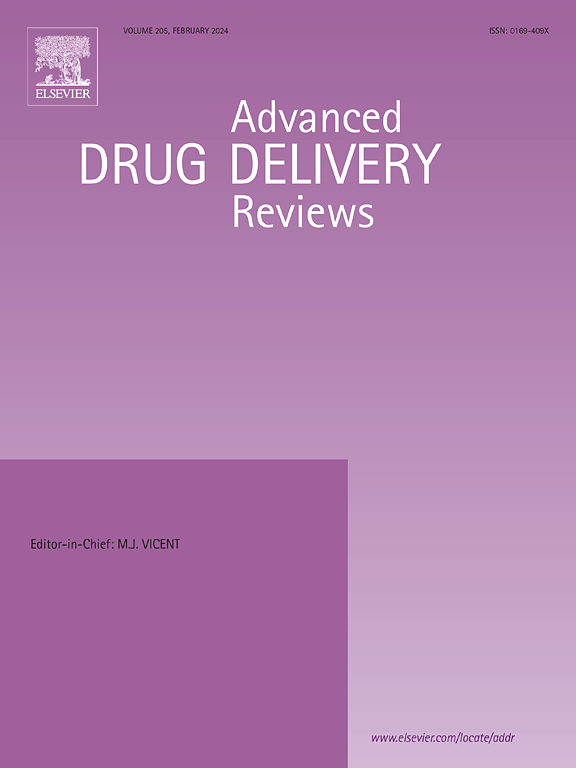Maximizing therapeutic potential and safety: Exploring multi/dual-payload antibody conjugates as cancer theranostics
IF 17.6
1区 医学
Q1 PHARMACOLOGY & PHARMACY
引用次数: 0
Abstract
Tumor heterogeneity greatly contributes to the failure of traditional cancer treatments. This leads to tumor relapse, recurrence, and ultimately metastasis, presenting serious clinical challenges. In recent decades, advances in antibody-based immunotherapy have emerged as promising new pillars to combat cancers. Although single payload antibody drug conjugates (ADCs) have resulted in drastic improvements in patient outcomes compared with unconjugated antibodies, multiple de novo and acquired resistance mechanisms inherent with cancer cells have left patients with less than desired outcomes. Newer studies are exploring the use of dual and multiple payload ADCs to enhance effectiveness. These payloads include chemotherapeutic and/or radiotherapeutic agents. The approaches leverage the synergistic effects of the different payloads alongside the immunotherapeutic properties of the antibody carriers. This review presents a comprehensive overview of dual-payload monoclonal antibody conjugates for cancer therapy and diagnosis (theranostics). Additionally, it explores the use of various imageable radiometals that are conjugated to the ADCs for imaging/diagnosis. It discusses the role of radioisotope decay schemes (such as alpha emission, beta emission, or Auger electron emission) along with factors such as linker type and chelator, as well as drug-to-antibody ratio (DAR), which are aimed at enhancing the synergistic effects between the therapeutic payloads while ensuring safety. Because none of these dual-payload ADCs have reached the clinic, this review employs a predictive method to estimate human equivalent dose (HED), maximum tolerable dose (MTD), and radiotoxicity in humans based on preclinical data. Additionally, it discusses the combinatorial behavior of two cytotoxic payloads linked to a monoclonal antibody.


最大限度地提高治疗潜力和安全性:探索多/双有效载荷抗体偶联物作为癌症治疗药物
肿瘤的异质性在很大程度上导致了传统癌症治疗的失败。这导致肿瘤复发,复发,并最终转移,提出了严重的临床挑战。近几十年来,基于抗体的免疫疗法的进展已经成为对抗癌症的有希望的新支柱。尽管与非结合抗体相比,单有效载荷抗体药物偶联物(adc)显著改善了患者的预后,但癌细胞固有的多重新生和获得性耐药机制使患者的预后不如预期。较新的研究正在探索使用双和多有效载荷adc来提高有效性。这些有效载荷包括化疗和/或放射治疗剂。这些方法利用了不同有效载荷的协同效应以及抗体载体的免疫治疗特性。本文综述了双有效载荷单克隆抗体偶联物用于癌症治疗和诊断(治疗学)的全面概述。此外,它还探讨了与adc共轭的各种可成像放射性金属用于成像/诊断的使用。它讨论了放射性同位素衰变方案(如α发射、β发射或俄歇电子发射)的作用,以及诸如连接剂类型和螯合剂以及药物与抗体比率(DAR)等因素,这些因素旨在增强治疗有效载荷之间的协同效应,同时确保安全性。由于这些双载荷adc尚未进入临床,本综述采用一种基于临床前数据的预测方法来估计人体等效剂量(HED)、最大耐受剂量(MTD)和人体放射毒性。此外,它还讨论了与单克隆抗体相连的两种细胞毒性有效载荷的组合行为。
本文章由计算机程序翻译,如有差异,请以英文原文为准。
求助全文
约1分钟内获得全文
求助全文
来源期刊
CiteScore
28.10
自引率
5.00%
发文量
294
审稿时长
15.1 weeks
期刊介绍:
The aim of the Journal is to provide a forum for the critical analysis of advanced drug and gene delivery systems and their applications in human and veterinary medicine. The Journal has a broad scope, covering the key issues for effective drug and gene delivery, from administration to site-specific delivery.
In general, the Journal publishes review articles in a Theme Issue format. Each Theme Issue provides a comprehensive and critical examination of current and emerging research on the design and development of advanced drug and gene delivery systems and their application to experimental and clinical therapeutics. The goal is to illustrate the pivotal role of a multidisciplinary approach to modern drug delivery, encompassing the application of sound biological and physicochemical principles to the engineering of drug delivery systems to meet the therapeutic need at hand. Importantly the Editorial Team of ADDR asks that the authors effectively window the extensive volume of literature, pick the important contributions and explain their importance, produce a forward looking identification of the challenges facing the field and produce a Conclusions section with expert recommendations to address the issues.

 求助内容:
求助内容: 应助结果提醒方式:
应助结果提醒方式:


